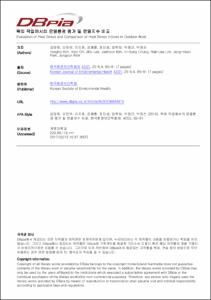KUMEL Repository
1. Journal Papers (연구논문)
1. School of Medicine (의과대학)
Dept. of Preventive Medicine (예방의학)
옥외 작업에서의 온열환경 평가 및 온열지수 비교
- Keimyung Author(s)
- Chung, In Sung
- Department
- Dept. of Preventive Medicine (예방의학)
- Journal Title
- 한국환경보건학회지
- Issued Date
- 2016
- Volume
- 42
- Issue
- 2
- Keyword
- Heat; Heat stroke; Outdoor work; WBGT oC
- Abstract
- Objectives: The objective of this study was to assess heat stress, compare heat stress indices, and evaluate the
usefulness of wet bulb globe temperature (WBGT) among outdoor workers exposed to heat during the summer
season.
Methods: WBGT, dry temperature, and heat index were measured using WBGT measurers (QUESTemp 32
model and QUESTemp 34 model, QUEST, WI, USA) by industrial hygienists from August 27 to September 16,
2015. Heat stress indices were measured at the workplaces of a shipbuilder in Ulsan and a construction site in
Daegu. The dry temperature observed by the Automated Synoptic Observing System (ASOS) of the Korea
Meteorological Administration was also compared.
Results: Dry temperature measured by WBGT is different from that by ASOS. The temperature obtained from
ASOS was less than 33oC, above which point a heat wave is forecast by the Korea Meteorological Administration.
A heat index above 32.8oC as a moderate risk was not observed during measurement. WBGT was consistently
higher than 22oC, above which the risk of heat-related illness is increased in unacclimated workers involved in
work with a high metabolic rate. WBGT was sometimes higher than 28oC, above which the risk of heat-related
illness is increased in acclimated workers involved in work with a moderate metabolic rate in September.
Conclusion: According to the measurement of heat stress indices, WBGT was more sensitive than heat index
and temperature. Thus, general measures to prevent heat-related diseases should be implemented in workplaces
during the summer season according to WBGT.
- Keimyung Author(s)(Kor)
- 정인성
- Publisher
- School of Medicine
- Citation
- 김양호 et al. (2016). 옥외 작업에서의 온열환경 평가 및 온열지수 비교. 한국환경보건학회지, 42(2), 85–91. doi: 10.5668/JEHS.2016.42.2.85
- Type
- Article
- ISSN
- 1738-4087
- Appears in Collections:
- 1. School of Medicine (의과대학) > Dept. of Preventive Medicine (예방의학)
- 파일 목록
-
-
Download
 oak-2016-0290.pdf
기타 데이터 / 2.97 MB / Adobe PDF
oak-2016-0290.pdf
기타 데이터 / 2.97 MB / Adobe PDF
-
Items in Repository are protected by copyright, with all rights reserved, unless otherwise indicated.